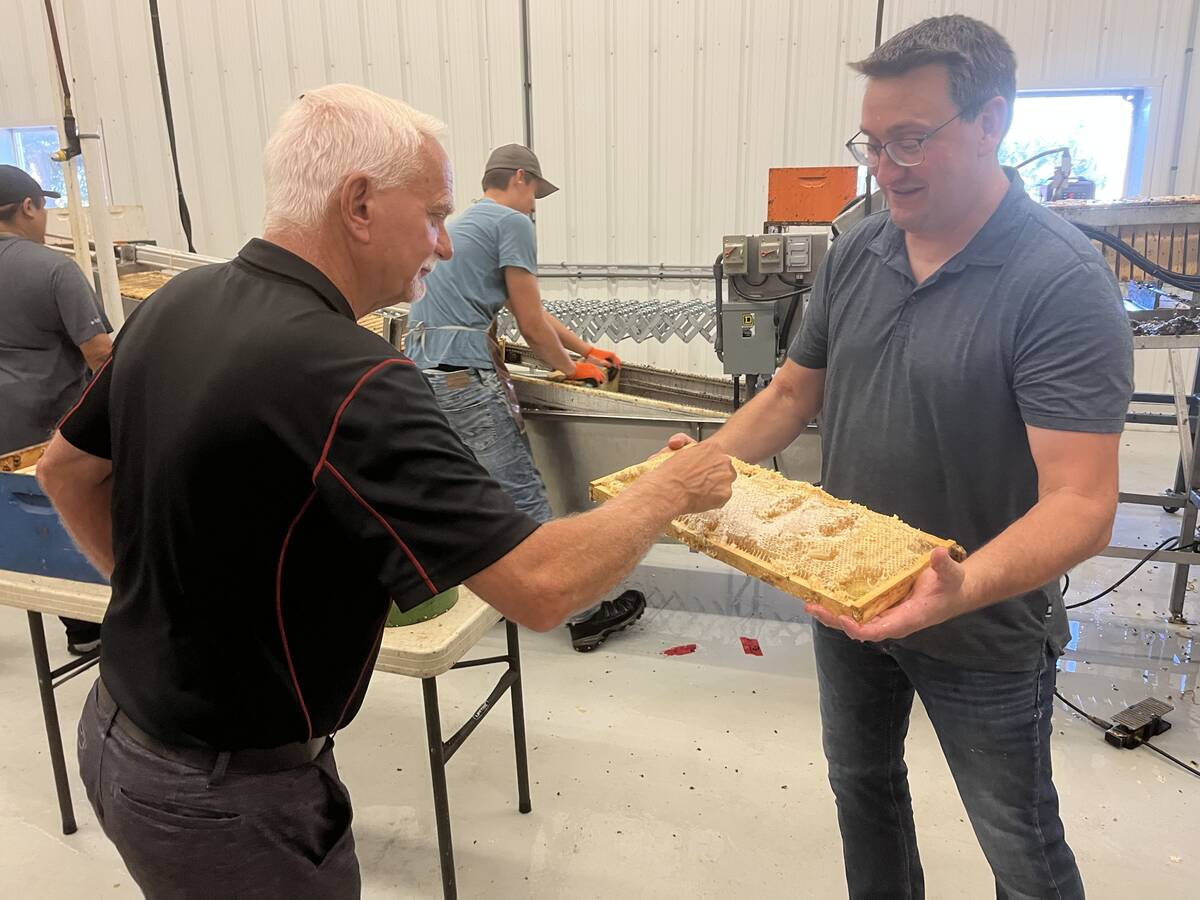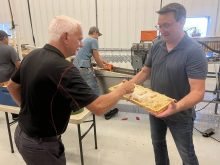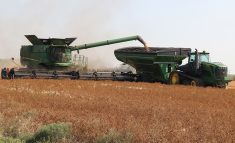CUPAR, Sask. – Next year Bill and Joan Turner’s farm could receive a century designation, if they can track down the original deed to the land.
“This was my grandfather’s farm. He bought it in October 1905 and farmed it in ’06,” said Bill.
The Turners still live in the big house that his grandfather built near Cupar in 1918 from yellow bricks made in Portage la Prairie, Man. They recently renovated the house and Bill said the workers told him the brick structure was still true and square.
Read Also

Alberta honey business ‘thrives’ despite bumpy beginnings
Thrive Honey showcases its honey production in market where Alberta produces 40 per cent of all honey produced in the country
When Bill’s grandfather died in 1943, his father received an early discharge from the air force to take over the farm. He brought his wife, whom he had met in Toronto.
Bill’s turn to take over the farm came gradually.
“There may have been an expectation I would farm, but no pressure.”
He was studying for a bachelor’s degree in agriculture at the University of Saskatchewan in 1962 when his father called and asked if he was interested in farming. His father had a chance to rent 21/2 sections of land to add to the original 240 acres he owned, but he needed to know his two sons would help him work it. They both said yes.
Bill then began a dual lifestyle of studying, eventually gaining his master’s in agriculture, while farming at home on weekends and summers.
Joan was a nursing student he had met at university and later married. She joked that 1967 was the year her mother’s centennial project was completed when Joan and her twin sister were married within months of each other.
By 1970, the Turners had settled into a roving life of summers on the Cupar farm and winters in Saskatoon where he taught at the U of S school of agriculture and she worked for the Victorian Order of Nurses. Through the 1970s Joan said they would “just house-sit. We never moved furniture.” Two daughters were added that decade as the Turners grew wheat and barley commercially, and also ran a seed growing business.
“The 1970s were good for farming,” Bill said. “I remember selling my first bushel of wheat for $1.25. It was the LIFT (Lower Inventories for Tomorrow) program and the smart guys were growing more wheat rather than getting out of it.”
In 1978 Bill and Joan moved into the brick home on the farm. It was Nov. 11, 60 years to the day that his grandfather had moved in. They modernized it and settled in for full-time farming.
Bill had a partnership with his father and brother in which each contributed labour and machinery and received a share based on their contribution. They farmed 41/2 sections of land by 1978, most of it a good grade of soil on the edge of a former glacial lake that had deposited silt.
“We rented a lot of land so we didn’t have mortgage debt when the interest rates went through the roof in the 1980s,” Bill said.
Joan raised their daughters and worked as a nurse at the local hospital. She limited her involvement with the farm to driving trucks in the fall or running for parts.
“We had cattle growing up (on a Davidson, Sask., farm) and I hauled bales and picked stones. Dad always figured we needed an education,” Joan said.
That drive for further education was passed on to their children, one of whom earned her masters in business administration while the other has a master’s degree in kinesiology. Neither girl was interested in farming. Joan joked that they didn’t even like to garden while Bill recalled having to threaten that there would be no family summer vacation until the girls had finished hand picking the weeds in the breeder seed plots.
With no one in the immediate family to take over, the Turners decided three years ago to retire and rent out their land. Bill helps the renter with fieldwork.
One side of the agricultural life that led the Turners to countries around the world was Bill’s volunteer work in the co-operative sector.
Bill’s father and father-in-law were Saskatchewan Wheat Pool delegates and his father helped organize the Cupar co-op in the 1930s.
Bill didn’t take an active interest in organizations until 1981 when he was asked to run for the board of the Cupar credit union. He was elected based on his initial opposition to merging with Regina’s Sherwood Credit Union.
After two years on the board, Bill changed his mind and said the amalgamation should go ahead. It did, and Bill then spent 16 years as a Sherwood director, which led him to the Credit Union Central board and the position of president.
“Then that takes you everywhere.”
One of his fondest tasks was to be on the board of the U of S Centre for the Study of Co-operatives, working with former students and associates.
He also became president of the Canadian Co-operative Association and regional president for the International Co-operative Alliance. He travelled to co-op projects in Asia, Central and South America and Canada. Sometimes Joan accompanied him.
She noted that “sometimes co-ops are in style, sometimes not.”
Bill said that even the fiercely independent beef producers are now looking at working together to build packing plants.
He tells people that co-ops and credit unions bring money back into a local community, unlike a Wal-Mart where the money goes elsewhere.
As for the future for Canadian farmers, Bill said the issue should be fair trade, not free trade, to create opportunities for people to share the benefits. Unfettered trade is not good because it does not include responsibility for the environment or social issues, he said.
That is why organics is becoming a strong niche, he added, because “people bring more than an economic dimension to their decisions. It’s not always about the bottom line.”
The Turners plan to stay in their farm home but do a lot more travelling. Next up this fall are trips to Italy and England for family weddings. After that, India and China are on Joan’s wish list.
















